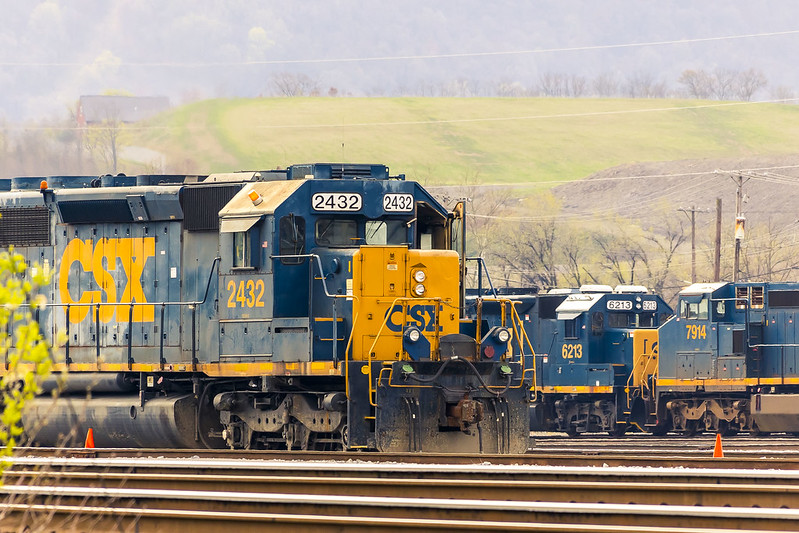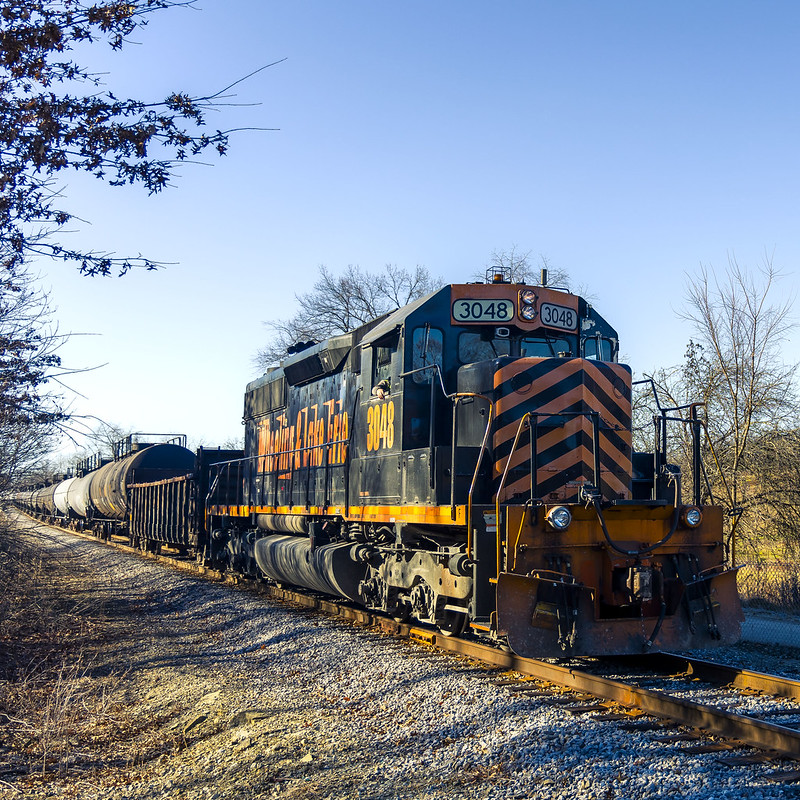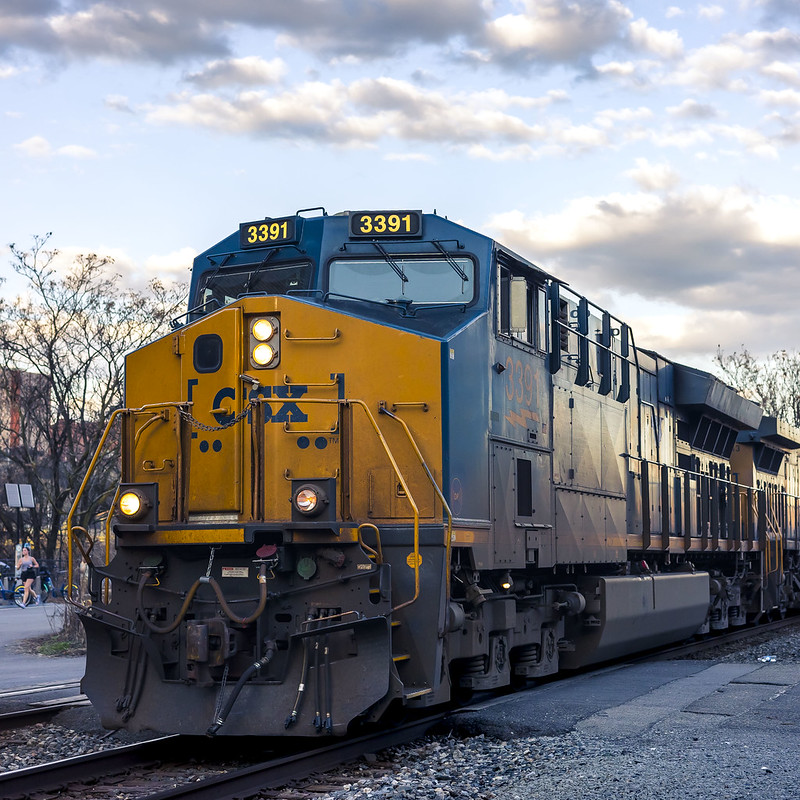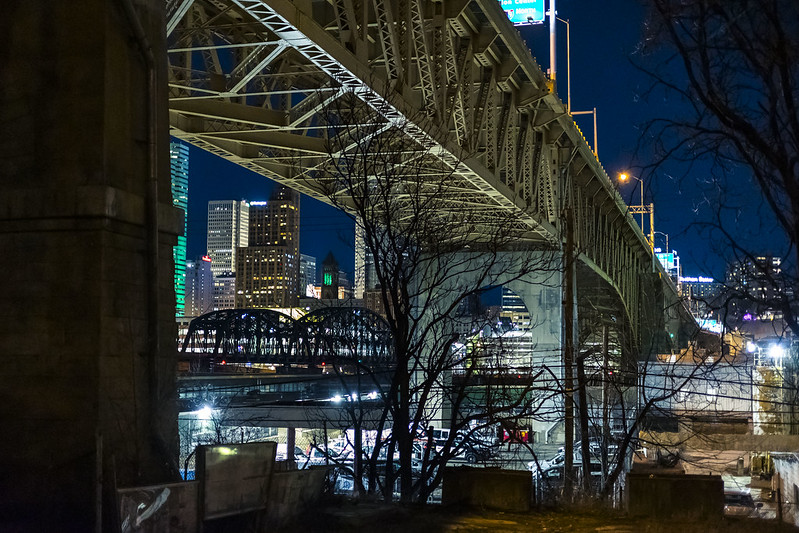Posts Tagged ‘railroad’
CSX Cumberland apertif
Thursday

– photo by Mitch Waxman
Finally, I found a point of view location for the CSX Terminal in Maryland’s city of Cumberland. Take that, jabronies.
One realizes that this quest of mine sounds fairly obsessive, and I haven’t been able to get close at all to what I really want shots of (the roundhouse), but… darn it… this is the closest I’ve managed to get to the facility and I was glad of it.
This whole ‘train thing’ has been a real learning experience, I tell you, but I’m not done yet. Learning, learning, learning.

– photo by Mitch Waxman
This is my second or third day trip to this area, which is about a two hour drive, and what I’d consider to be the southeastern corner of the Pittsburgh metroplex. A significant section of the journey takes place on the modern incarnation of the ‘National Road’ – Route 40, which dates back to 1812, and travels through the Laurel Highlands. If you’re interested in seeing an absolutely gorgeous section of the eastern United States – put the Laurel Highland on your list.
Cumberland is high on my ‘to explore’ list, and I’ll definitely be trying to pay the place a good amount of attention while waving the camera around.

– photo by Mitch Waxman
An oddly painted track maintenance unit was spotted at the Cumberland Terminal, all decked out in the sort of urban camouflage pattern which the military favors. Can’t imagine why you’d paint equipment like this in such a manner, but there you go. Normally these sorts of things are brightly painted so you can’t ‘not notice’ them.
Back tomorrow.
“follow” me on Twitter- @newtownpentacle
Buy a book!
“In the Shadows at Newtown Creek,” an 88 page softcover 8.5×11 magazine format photo book by Mitch Waxman, is now on sale at blurb.com for $30.
Up, down, and around
Wednesday

– photo by Mitch Waxman
Yup… that’s the shot I was hoping for after walking down a thousand feet of steps. Norfolk Southern #1024. It’s an EMD SD70ACe model locomotive if that means anything to you. What warmed the cockles of my heart, however, was what it was hauling. Check it out. I recognize those containers, and so will longtime readers of this publication. You really never can escape NYC, or its trash.
As mentioned yesterday, I’ve sort of been systematically exploring legally available POV’s for this Norfolk Southern Right of Way. Call me timid, but my way has always been to not knowingly trespass. Admittedly, I break this rule a little bit here and there, but otherwise it’s followed as such activity is generally outside of my comfort zone.
I never want to be the guy who needs the Fire Department to come rescue me after falling through a rotting floor or something.

– photo by Mitch Waxman
This one looks back up at the last sections of the German Square steps which I had walked about a thousand feet down on from Arlington Avenue.
My friend Tim Fabian has actually photographed all the steps of Pittsburgh, and his photos are available in this book. Personally, I will not be photographing all of the seven hundred and twelve sets of steps Pittsburgh offers. Tim is insane, just ask him.
Suffice to say that going downwards on these steps is a bit less of an athletic undertaking than going up would be, but also as mentioned the path down provided access to less commonly used musculature in the roadway interface and I really felt it in my knees, thighs, and hips.

– photo by Mitch Waxman
The Norfolk Southern train set, hauling NYC’s garbage, moved westerly through Pittsburgh in the direction of the P.J. McArdle roadway. My day was half over at this point, but there were still a couple of spots in the South Sides Flats area where my desire to point the camera at things could be satisfied.
Back tomorrow.
“follow” me on Twitter- @newtownpentacle
Buy a book!
“In the Shadows at Newtown Creek,” an 88 page softcover 8.5×11 magazine format photo book by Mitch Waxman, is now on sale at blurb.com for $30.
Wassup in Sewickley
Friday

– photo by Mitch Waxman
Sewickley is a Borough in Pennsylvania’s Allegheny County, found about 12 miles northwest of Pittsburgh proper, and is home to about 4,000 people. It’s quite a lovely and seemingly well-off suburb, I would mention.
There’s a park and a boat launch along the Ohio River, the access road of which is pictured above as it tunnels under the Norfolk Southern tracks which I’d been shadowing all afternoon and has been mentioned in prior posts. In the shot above, the tracks are carried above the boat launch tunnel, with the Ohio River in the background.
After one walked through the tunnel, surprising a couple of people who were surreptitiously enjoying some cannabis, one discovered that the views attainable here weren’t terribly photogenic so I walked up a nearby hill to try and find a POV.

– photo by Mitch Waxman
The Sewickley Bridge came into frame at the hill top, a 1981 vintage truss which spans the Ohio and carries State Route 4025 – which connects Sewickley to Moon Township on the south side of the river. I’d be driving over that bridge before the afternoon was over, on my way back to HQ.
One scuttled about, and I received a phone call from an old friend while doing so, who’s been referred to here as ‘The Hermetic Hungarian.’ We caught up and discussed the issues of the day while I scuttled about and crossed my fingers that I might get a shot of a train, after haunting these tracks in different locations all afternoon.

– photo by Mitch Waxman
Wishes do come true, apparently, as Norfolk Southern #4781 came roaring into view. I’m told that’s an ‘EMD SD70MAC’ model locomotive.
That probably means quite a bit to someone versed in the railfanning hobby, but as is often stated – I like taking pictures of trains, and photos always need subjects to focus on. Trains are also sort of difficult to photograph, especially so when they’re under full steam and cooking along their way. Not railfanning, however.
Back next week, with something different at this – your Newtown Pentacle.
“follow” me on Twitter- @newtownpentacle
Buy a book!
“In the Shadows at Newtown Creek,” an 88 page softcover 8.5×11 magazine format photo book by Mitch Waxman, is now on sale at blurb.com for $30.
Second Interruptus
Tuesday

– photo by Mitch Waxman
Happily, I can report that the bug which has been afflicting me has fallen, and destroyed by my mighty immune system, as buoyed up by dozens of hours of sleep. Felt like hell for about 24 hours there, this was a ‘wild eyes looking back at you from the bathroom mirror at 4 in the morning’ kind of thing. Nothing survives within me for long. My gaze causes inflammation in the healthy, imagine what it’s like within.
Back tomorrow with proper offerings at this – your Newtown Pentacle.
“follow” me on Twitter- @newtownpentacle
Buy a book!
“In the Shadows at Newtown Creek,” an 88 page softcover 8.5×11 magazine format photo book by Mitch Waxman, is now on sale at blurb.com for $30.
Disfunction Junction
Monday

– photo by Mitch Waxman
A gorgeous spring-like day saw a humble narrator walking all over Pittsburgh, as detailed in last week’s posts. The end of my longish scuttle occurred, and I settled in at an often visited brewery which is located along the Three Rivers Heritage Trail and the ‘Colors Park,’ where outdoor seating and active railroad tracks used by the CSX outfit are found.
I’m very fond of this spot, as it’s a grade crossing (the tracks intersect with a local street) with signal alarms that alert you when a train is nearing, and thereby you have ample warning to get into position and frame your shot. Also, there’s beer.
Choo Choo.

– photo by Mitch Waxman
One ended up having more than one glass of beer, I’ll confess, and it was dark when I set out for the T Light Rail station to acquire a ride home. I was testing out the ‘fail zone’ of a newish 50mm f1.8 lens on this leg of the day, I should mention.
The 50mm lens is pretty bare bones, electronics wise, and doesn’t offer ‘image stabilization’ technology inside the housing. My camera has an internal sensor based stabilization system, which gives me about three stops of wiggle room, but when I attach a stabilized lens to the thing I get an amazing eight stops worth of mechanical assist. The lack of stabilized glass on the thing caused me to throw away a few train shots, which just weren’t sharp enough to ‘make the grade.’
I made a mental note about sticking with my stabilized f1.8 35mm, or 85mm f2, for handheld night shots like the one above.

– photo by Mitch Waxman
Back home in Dormont some five miles away, and just as I was leaving the T Light Rail station, a Pittsburgh bound T train set was seen leaving the station. Couldn’t resist.
Back tomorrow with something different – at this – your Newtown Pentacle.
“follow” me on Twitter- @newtownpentacle
Buy a book!
“In the Shadows at Newtown Creek,” an 88 page softcover 8.5×11 magazine format photo book by Mitch Waxman, is now on sale at blurb.com for $30.




